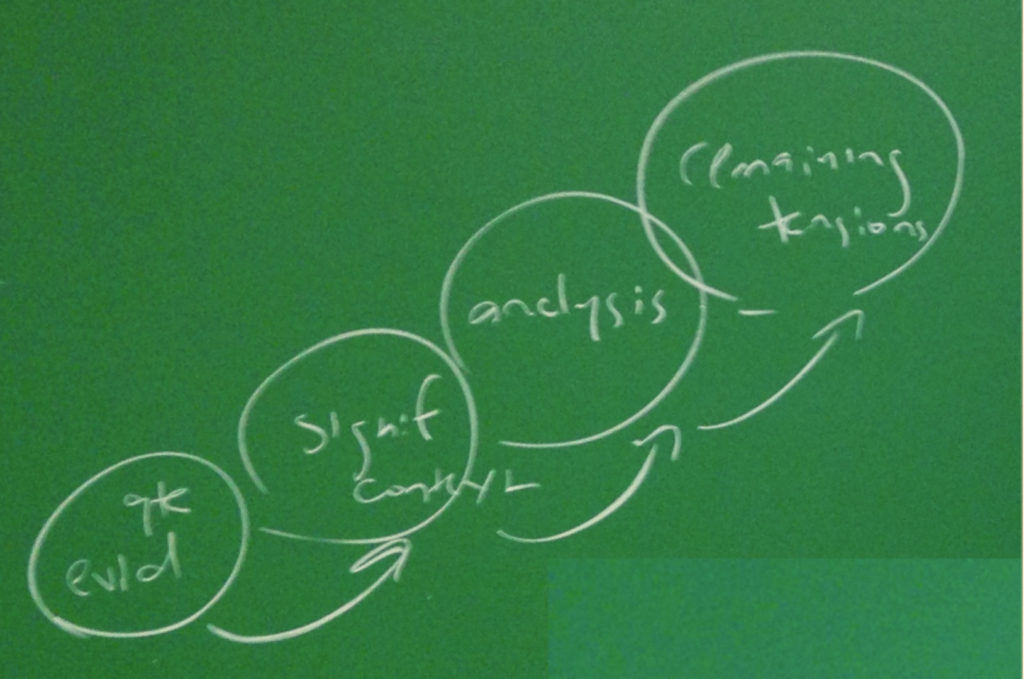What does a centrifuge do?
That’s the question I ask, in the first week of every course I teach, as I introduce this writing model. Sometimes the science majors perk up—the first question, in this required class seemingly far outside their major, speaks directly to their interests.
A centrifuge spins round and round, they often answer. A detail. OK, but why? I ask. A pause, and then a better answer: to separate things. Even better: To refine them.
Then the conversation gets radioactive.
What process uses a chain of centrifuges? Uranium enrichment, from less than one percent U-235 to a few percentage points, up to a nuclear-grade concentration of twenty percent—that is the work of centrifuges, spinning and separating, the product of one round of refinement pushed even farther in the next.
I draw four ovals on the board, in an ascending series, the line looping from one to the next. Week in and week out we will practice, I explain; the iterative process is its own form of refinement.
My centrifuge model of reading response papers builds upon this analogy: that students can purify, and refine, and deepen their analysis over the course of four paragraphs, with a model that can work as a rhetorical frame in any course.
The four paragraphs I require are:
Detail. Pick one telling detail from the night’s reading. If you can quote it and properly cite it, even better. But just one—not a list of key points, not a summary. (This paragraph tends to be easy points. Unless they summarize.)
Significance. Explain how the telling detail reveals something that will be important to our class discussion, ideally on the day it is due, but perhaps some time in this unit or this semester. Why does this detail matter? (As even a keyword identification can reveal, getting the significance right is hard, but I do offer half credit at times.)
Implications. This is where I ask students to stretch. How might this little detail be a “little door”* into a controversial theory, or a moment of insight? How far can you take the significance of that detail? What multitudes may be hiding inside? The more passionate the claim the better. (If the students love a good rant, this gets easier—though many are unaccustomed to placing their own arguments and opinions so prominently in a paper, even one asking for their personal response.)
Remaining Tensions. An argument, filled with implications, is an accomplishment, I explain. But to be able to identify the gaps in that arguments, the items that a rant might overlook, the countervailing pressures and tensions left unresolved, the acknowledgment of humility—that is a depth of analysis, a sophistication in thinking, that only the best writing assignments achieve. And so I am asking that they practice it, in each written response, to build up the depth and sophistication of their arguments. (These points are hard to garner, so they function almost like extra credit.)
The paragraphs can be short, or they can be pages long; some students can punch out a quality centrifuge assignment in an hour, while others complain that it takes them hours to complete. I explain from the outset that they can argue whatever they wish, about whatever detail seemed important to them; not a few find that freedom daunting. As they look at models I provide and respond to my feedback on each of the four paragraphs, they might begin frustrated, but focused: the conversation turns immediately to depth of analysis and mastery of the rhetoric, not merely recall of facts. As they master the form, they begin to talk about centrifuges as writing, the metaphor becoming their new reality.
I love grading my centrifuge assignments. I assign them after the reading and before class, so they let me know what students understand before the discussion. I always learn something, about their reading practices, their insights, and their attitudes toward the subject matter at hand. And, week after week, this iterative assignment teaches students to read closely, think deeply, stretch to the widest implications, and be able to admit what their arguments leave unresolved.
The centrifuge analogy has helped me explain to students—majors and nonmajors alike—how to find a small entry point into the week’s readings, and how to push their arguments and analysis deeper. Having the assignment iterate throughout the semester gives students a chance to learn my standards, understand the assignment, and excel as they apply its approach to new course material. I have found that it truly refines students’ thinking in written assignments—something definitely worth spinning about.
(As I write up more of my strategies for teaching student writing, you can find them here.)
——
- In his 2009 book War of a Thousand Deserts: Indian Raids and the U.S.-Mexican War, Brian DeLay calls Article XI of the Treaty of Guadalupe Hidalgo “a little door into a big story, one told only in pieces by borderlands anthropologists and historians and forgotten altogether by the broader national and international histories of the era.” (p. xv) That image—a small, almost-forgotten detail becoming transformative and opening into a wide, unexplored set of implications and tensions—has stuck with me, and it likely had a role in my developing the centrifuge assignment.
